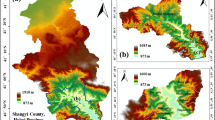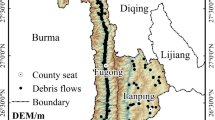Abstract
Understanding the interaction of debris flow with different arrangements of buildings and providing an accurate and real-time predictions for the corresponding flow distribution has become a challenging task. Two parts of this problem, namely new constructions and rapid reaction, have made this as a daunting topic. Although the numerical methods can provide precise predictions, their applicability due to the above-mentioned issues is challenging as one has to redo the computations when new buildings are added. In this paper, thus, a deep learning model is developed to efficiently predict the spatiotemporal distribution of debris flow as it interacts with different building arrangements. As such, we employed U-net as the base model, which is combined with the residual network to alleviate the gradient vanishing issue. An autoregressive strategy is proposed to help the model capture the dynamics of the debris flow, where the output at the previous timestep is used as the input to predict the current timestep. A synthetic dataset based on the numerical methods is used to train the residual U-net model. The results indicate that the proposed method can predict the general trend at different timesteps, and its robustness is verified using an extensive sensitivity analysis.









Similar content being viewed by others
Explore related subjects
Discover the latest articles, news and stories from top researchers in related subjects.References
Mcardell BW (2016) Field measurements of forces in debris flows at the illgraben: implications for channel-bed erosion. Int J Eros Control Eng 9:194–198. https://doi.org/10.13101/ijece.9.194
Johnson CG, Kokelaar BP, Iverson RM et al (2012) Grain-size segregation and levee formation in geophysical mass flows. J Geophys Res Earth Surf. https://doi.org/10.1029/2011JF002185
Benito J, Bertho Y, Ippolito I, Gondret P (2012) Stability of a granular layer on an inclined “fakir plane.” EPL. https://doi.org/10.1209/0295-5075/100/34004
Ng CWW, Choi CE, Song D et al (2014) Physical modeling of baffles influence on landslide debris mobility. Landslides 12:1–18. https://doi.org/10.1007/s10346-014-0476-y
Luong TH, Baker JL, Einav I (2020) Spread-out and slow-down of granular flows through model forests. Granul Matter 22:15. https://doi.org/10.1007/s10035-019-0980-9
Gray JMNT, Cui X (2007) Weak, strong and detached oblique shocks in gravity-driven granular free-surface flows. J Fluid Mech 579:113–136. https://doi.org/10.1017/S0022112007004843
Pudasaini SP, Hutter K, Hsiau SS et al (2007) Rapid flow of dry granular materials down inclined chutes impinging on rigid walls. Phys Fluids 19:053302. https://doi.org/10.1063/1.2726885
Gray JMNT, Wieland M, Hutter K (1999) Gravity-driven free surface flow of granular avalanches over complex basal topography. Proc R Soc London Ser A Math Phys Eng Sci 455:1841–1874. https://doi.org/10.1098/rspa.1999.0383
Bouchut F, Mangeney-Castelnau A, Perthame B, Vilotte JP (2003) A new model of Saint Venant and Savage-Hutter type for gravity driven shallow water flows. Comptes Rendus Math 336:531–536. https://doi.org/10.1016/S1631-073X(03)00117-1
Bouchut F, Westdickenberg M (2004) Gravity driven shallow water models for arbitrary topography. Commun Math Sci 2:359–389
Viroulet S, Baker JL, Edwards AN et al (2017) Multiple solutions for granular flow over a smooth two-dimensional bump. J Fluid Mech 815:77–116. https://doi.org/10.1017/jfm.2017.41
Cui X, Gray JMNT (2013) Gravity-driven granular free-surface flow around a circular cylinder. J Fluid Mech 720:314–337. https://doi.org/10.1017/jfm.2013.42
O’Brien JS (1986) Physical processes, rheology and modeling of mudflows. Colorado State University, US
Armanini A, Fraccarollo L, Rosatti G (2009) Two-dimensional simulation of debris flows in erodible channels. Comput Geosci 35:993–1006. https://doi.org/10.1016/j.cageo.2007.11.008
Christen M, Buhler Y, Bartelt P, et al (2012) Integral hazard management using a unified software environment. Numerical simulation tool “RAMMS”; for gravitational natural hazards. 12th Congress INTERPRAEVENT 2012 23 to 26 April 2012 Grenoble, Fr Conference Proceedings “Protection living Sp from Nat hazards” 77–86
Bai T, Tahmasebi P (2020) Hybrid geological modeling: Combining machine learning and multiple-point statistics. Comput Geosci. https://doi.org/10.1016/j.cageo.2020.104519
Bai T, Tahmasebi P (2020) Efficient and data-driven prediction of water breakthrough in subsurface systems using deep long short-term memory machine learning. Comput Geosci. https://doi.org/10.1007/s10596-020-10005-2
Tahmasebi P, Kamrava S, Bai T, Sahimi M (2020) Machine learning in geo- and environmental sciences: From small to large scale. Adv Water Resour 142:103619. https://doi.org/10.1016/j.advwatres.2020.103619
Cui H, Zhang H, Ganger GR, et al (2016) Geeps: Scalable deep learning on distributed gpus with a gpu-specialized parameter server. In: Proceedings of the Eleventh European Conference on Computer Systems. pp 1–16
Tan C, Sun F, Kong T, et al (2018) A survey on deep transfer learning. In: Lecture Notes in Computer Science (including subseries Lecture Notes in Artificial Intelligence and Lecture Notes in Bioinformatics). Springer Verlag, pp 270–279
Kamrava S, Tahmasebi P, Sahimi M (2021) Physics- and image-based prediction of fluid flow and transport in complex porous membranes and materials by deep learning. J Memb Sci 622:119050. https://doi.org/10.1016/j.memsci.2021.119050
Kamrava S, Tahmasebi P, Sahimi M (2019) Linking morphology of porous media to their macroscopic permeability by deep learning. Transp Porous Media. https://doi.org/10.1007/s11242-019-01352-5
Kamrava S, Sahimi M, Tahmasebi P (2020) Quantifying accuracy of stochastic methods of reconstructing complex materials by deep learning. Phys Rev E 101:043301. https://doi.org/10.1103/PhysRevE.101.043301
Ronneberger O, Fischer P, Brox T (2015) U-net: Convolutional networks for biomedical image segmentation. In: Lecture Notes in Computer Science (including subseries Lecture Notes in Artificial Intelligence and Lecture Notes in Bioinformatics). pp 234–241
Glorot X, Bengio Y (2010) Understanding the difficulty of training deep feedforward neural networks. J Mach Learn Res 9:249–256
He K, Zhang X, Ren S, Sun J (2016) Deep residual learning for image recognition. In: Proceedings of the IEEE conference on computer vision and pattern recognition, pp 770–778
Long J, Shelhamer E, Darrell T (2015) Fully convolutional networks for semantic segmentation. In: Proceedings of the IEEE Computer Society Conference on Computer Vision and Pattern Recognition. IEEE Computer Society, pp 431–440
Simonyan K, Zisserman A (2014) Very deep convolutional networks for large-scale image recognition. arXiv preprint arXiv:1409.1556
Ioffe S, Szegedy C (2015) Batch normalization: Accelerating deep network training by reducing internal covariate shift. 32nd Int Conf Mach Learn ICML 2015 1:448–456
Bottou L (2010) Large-Scale Machine Learning with Stochastic Gradient Descent. In: Proceedings of COMPSTAT’2010. Physica-Verlag HD, pp 177–186
Kingma DP, Ba J (2014) Adam: A Method for Stochastic Optimization.
Zhang L, Zhang L, Mou X, Zhang D (2011) FSIM: A feature similarity index for image quality assessment. IEEE Trans Image Process 20:2378–2386. https://doi.org/10.1109/TIP.2011.2109730
Acknowledgements
The financial support from the University of Wyoming for this research is greatly acknowledged.
Author information
Authors and Affiliations
Corresponding author
Ethics declarations
Conflict of interest
The authors declare that they have no conflict of interest.
Additional information
Publisher's Note
Springer Nature remains neutral with regard to jurisdictional claims in published maps and institutional affiliations.
Rights and permissions
About this article
Cite this article
Bai, T., Jiang, Z. & Tahmasebi, P. Debris flow prediction with machine learning: smart management of urban systems and infrastructures. Neural Comput & Applic 33, 15769–15779 (2021). https://doi.org/10.1007/s00521-021-06197-y
Received:
Accepted:
Published:
Issue Date:
DOI: https://doi.org/10.1007/s00521-021-06197-y




